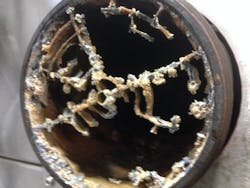As a young driver/engineer and fire apparatus mechanic, I have a fascination with pump operations, water supply and fire apparatus mechanics in general. Time and time again, over the last 12 years of my fire/EMS career, I’ve been honored to have seasoned driver/engineers share their hands-on experience, information, and failures with me to learn from.
One of the early lessons I learned as a pump operator was when a fellow firefighter and I were flowing water from a pumper/tanker during training at our volunteer department. We lost water pressure and could not figure out why. How could this be? The gauge showed that we had plenty of water.
In reality, the tank was empty. We were totally out of water, thanks to a faulty gauge. This is when I came to understand how important it was to take the initiative to learn the ins-and-outs of the apparatus I was going to be operating. Unfortunately, this is not always the case for young recruits.
My generation of firefighters, in particular, has been faced with an epidemic of lack of pride in being a pump operator, whether volunteer or career. A calm, smooth and efficient pump operator can make or break the fireground. We often take for granted that one big reason we leave a scene and the job went well is because of the pump operator. It is an awesome responsibility.
Are you an educated pump operator?
That raises the question, what kind of pump operator am I? Do I take my job seriously? Or am I happy if the truck starts, the Q and air horn sound, and the lights flash? I have been guilty of this kind of mentality myself. That’s why I want to share a few thoughts and photos that have helped me understand the importance of “Taking Pride in the Pump.”
Even if you have no interest in being an Apparatus Mechanic, all Driver/Engineers should have an intimate relationship with their equipment. I realize some departments (such as mine) might have their staff move to a different apparatus depending what the call or alarm might be. Knowing every piece of equipment can be challenging, but that is part of what makes our job so exciting!
Like most of us, I didn’t know that I would be dealing with concepts like vacuum, cavitation and electrolysis when I entered the fire service. We aren’t chemistry or hydraulics majors. Why should we need to know this as a firefighter?
Let’s take a look at electrolysis. For the sake of definition, electrolysis is “the chemical decomposition produced by passing an electric current through a liquid or solution containing ions.”
Here in Northern Kentucky, our water has large amounts of minerals that can be seen in most fittings and valves within several years of the apparatus being in service. Minerals produce scaling or build up and are evident as valves are becoming difficult to open and close. Most rural departments rely on static water sources such as ponds and creeks, and tanker water shuttles tend to see even larger scale issues with electrolysis.
It was only after repairing, rebuilding and researching, that I began to appreciate the science behind the equipment. That’s also when I got an idea of the amount of money involved when an apparatus needs to be taken out of service for repairs. Remember, anytime the fire chief has to make these expenditures, it costs the entire department, which in turn impacts taxpayers and, ultimately, our pay raises.
As pump operators, there are several steps we can take that will go a long way in preserving the life our pumps and valves, the Chief’s budget, and the pride of our great heritage:
- At the beginning of every shift, exercise the pump and pump valve. Build pressure and circulate water. Check for water leaks coming from the pump. Know how to manually operate the pump shift override in case the normal shift procedure will not engage or disengage.
- Make sure your primer works properly.
- Every time pressure is built in the pump, drain all the pump discharges to keep water from sitting in the plumbing. This keeps the effects of electrolysis at a minimum.
- If the pump is used in a drafting or lengthy pumping scenario, open up the large diameter intakes or steamer caps, remove the screens with needle nose pliers, and completely flush out the pump.
- Make sure all fittings and caps have gaskets.
- Share your knowledge with less experienced firefighters who are interested in learning how the equipment works.
- Have a checklist. It will expose problems prior to getting on scene and keeping any problems to a minimum.
- Be a thorough pump operator and do not settle for anything less than the best.
- Last, but not least, “Take Pride in the Pump!”
JASPER MILLER is a career firefighter/EMT with the Union, KY, Fire Protection District. He got involved with the fire/EMS service 13 years ago, serving with the Canaan, IN, Volunteer Fire Department. Miller also volunteers with Glencoe, KY, Fire Rescue where he is responsible for the maintenance of the department's fleet of apparatus. He is a part-time firefighter/EMT with the Verona, KY, Fire Department.






